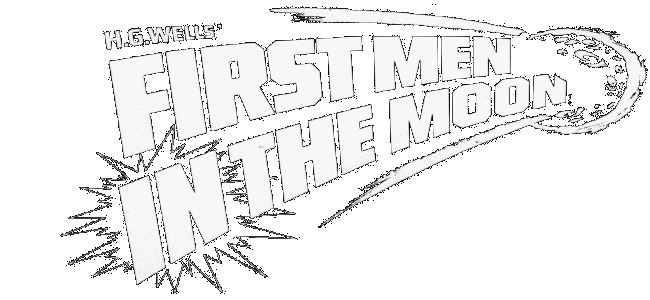

Screenplay: Nigel Kneale, Jan Read based on a novel by H.G. Wells; Cinematography: Wilkie Cooper; Music: Laurie Johnson; Special Visual Effects: Ray Harryhausen; Producer: Charles H. Schneer; Associate Producer: Ray Harryhausen; Director: Nathan Juran; Sound Mixer: Gordon K. McCallum.

Man's first expedition to the moon unleashes a startling mystery. As the astronauts explore the surface of the moon they discover a british Union Jack along with a note declaring the moon in the name of the British Empire. An investigation is launched back on earth where they discover an elderly man in a home who tells them mysterious story of his journey to the moon.
In his younger days he encounter an eccentric professor who claimed to have discovered a formula that works as a shield against gravity. This formula, when painted on an object, repels the force of gravity sending the object into the air. They begin to prepare for a journey to the man. The professor, hoping to explore the moon for scientific research and the younger man to bring back the precious minerals that the professor has promised him lie on the moon's surface. The younger man's fiancee isn't to happy about the idea and in a last minute attempt to stop them, finds herself on board their ship and heading to the moon with them.
Once their, they encounter the mysterious Selenites, insect-like inhabitants of the moon who take them prisoner. Now they must fight for their freedom and escape from the creatures in order to return from earth.
FIRST MEN IN THE MOON marked another first for Ray Harryhausen. Charles Schneer wanted to release the film in a Panavision widescreen process. This would make animating the sequence even more difficult and force Ray to go back to blue screen process instead of the yellow sodium process that he was getting wonderful results with.
Ray loved the writings of H.G. Wells and was excited about doing a film based on the classic novel. However, during the time the space program was advancing so rapidly and so much more known about the moon making certain elements of the novel difficult to bring to the screen. Using Harryhausen's concept sketches, Jan Reed developed the first draft of the screenplay. Nigel Kneele was then brought in for a re-write. Kneele was a well-known British writer who had developed several sci-fi BBC Radio programs and adapted a few of them for the screen. He is probably best known for his creation of the QUATERMASS character, seen in Hammers Studios THE QUATERMASS EXPERIMENT, QUATERMASS and QUATERMASS AND THE PIT (FIVE MILLION YEARS TO EARTH). Kneele came up with the idea of framing the story around a modern landing on the moon and the discovery of a Union Jack flag. He ingeniously reworked the Wells WAR OF THE WORLDS theme of a simple earth virus destroying all life on the moon.
Nathan Juran, who had directed 7TH VOYAGE OF SINBAD and 20 MILLION MILES TO EARTH for Schneer and Harryhausen was brought in to direct the film but before the filming began another change had to be made in the script. Columbia Pictures felt that the movie needed a female character in it. It's somewhat humorous to relate this back to KING KONG as Carl Denham explains why he has to have a woman in his film. Nigel Kneele was brought in again and a woman was added to the script. She was played by Martha Hyer. The two male leads went to Edward Judd as the aspiring playwright Bedford and Lionel Jeffries as the very eccentric Cavor. Though he is uncredited, Peter Finch makes a cameo as an officer who serves a summons to Martha Hyer.
There wasn't as much stop-animation in this film with only four major animated caricatures, the two Selenites, the Grand Lunar and a giant caterpillar creature referred to as the moon-cow. The animation of the Selenites and the Grand Lunar is exceptionally good. They move very insect-like but it serves as a pointer to the fact that the rest of the slave-worker selenites are children in bug costumes. Ray explained that it would have taken a lifetime to animate all of the Selenites so they reverted to costumed actors. The Selenite costumes are very clever and highly detailed. 20 to 30 suits were made and Harryhausen would use a split screen process to make the number of the insectoid Selenites double.
The Moon-Cow was very difficult to animate because of the number of legs on the creature. While the creature was adapted so there weren't as many legs as a real caterpillar, it still required particular attention during the animation of the creature in keeping track of the direction each of the legs was moving.
Arthur Hayward joined Harryhausen again with sculpting the models and Les Bowie and his crew were brought in to help with the miniature landscapes and the interiors of the Selenites massive cave. Ray also worked with John Blezard on the creation of the lunar landscape striving successfully to duplicate the geography of the moon.
FIRST MEN IN THE MOON, though not as profitable as 7TH VOYAGE OF SINBAD was a financial success, scoring another hit for the Harryhausen/Schneer team. The timing for the release of the film couldn't have been better. The NASA space program was in full swing and drawing the attention of everyone as we were getting closer to place a man on the moon. In fact, when CBS aired their broadcast of the actual lunar landing they used clips from FIRST MEN IN THE MOON to illustrate what the lunar landing would be like.
Our print of FIRST MEN IN THE MOON is a TV print as is presented flat and not in panavision as originally seen in the theaters. It's a good print with very few splices but the color has turned giving it a slightly pink color.
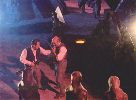 |
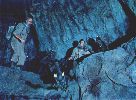 |
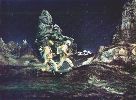 |
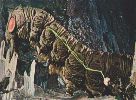 |
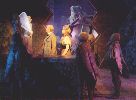 |
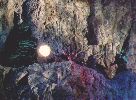 |
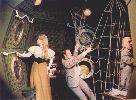 |
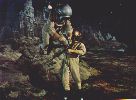 |

| Home | Features | Short Subjects | Autographs | Equipment |